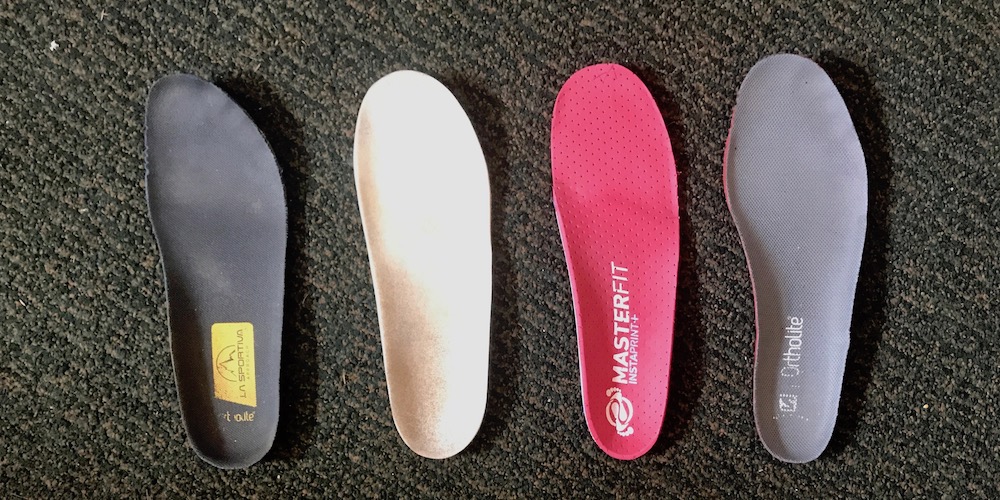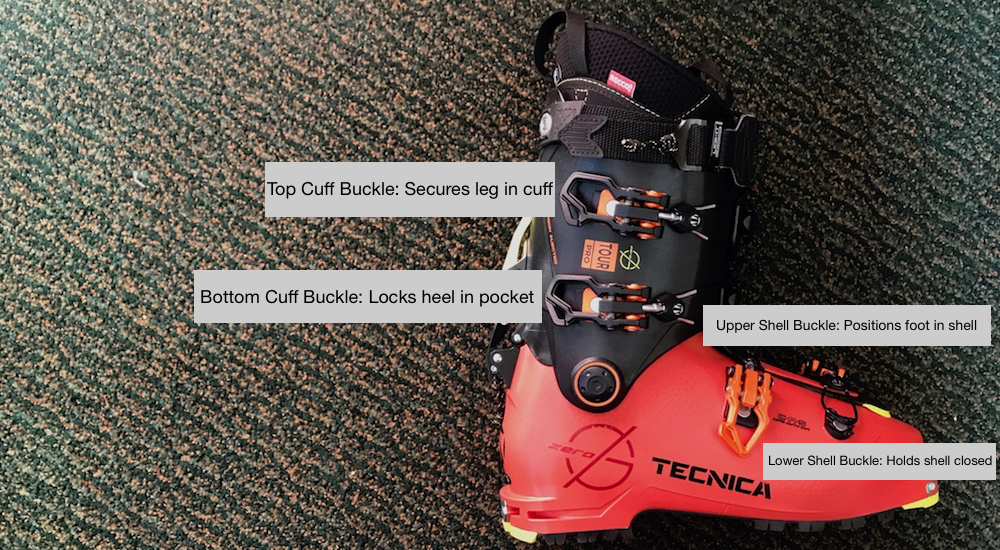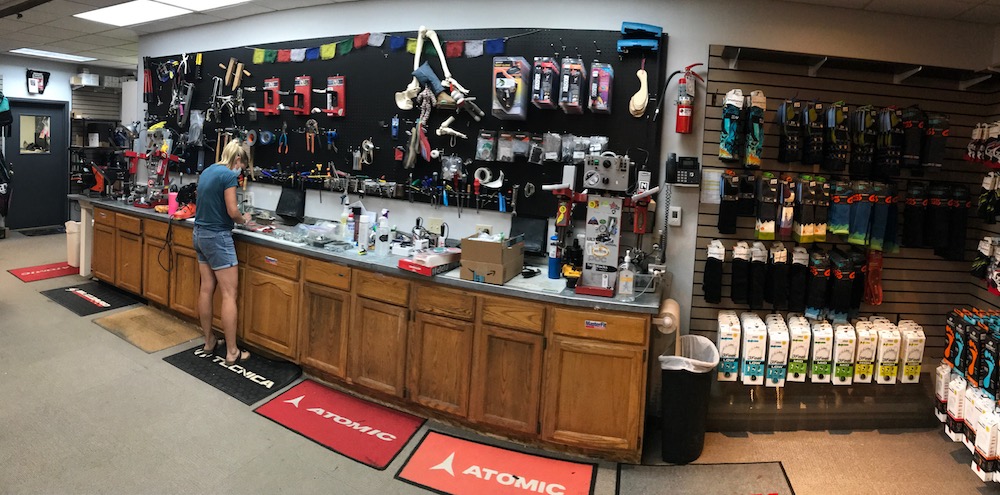![Sam pictured here with her masterpieces: handcrafted footbeds, heat molded liners, and her big [behind the mask] smile.](https://wildsnow.com/wp-content/uploads/2020/09/bootfit2.jpeg)
Sam Tischendorf pictured here with her masterpieces: handcrafted footbeds, heat molded liners, and her big [behind the mask] smile.
Each Fall marks the time when I start to bring my backcountry touring gear out of storage. It’s a distinct seasonal shift to slide into ski socks and check on how the backcountry boots are fitting.
Out of flip flops.
Into ski socks.
And the slow hesitant slip of my feet into touring boots.
Do they fit? Are the liners packed out? Can my soft, sun kissed feet handle the dark coffin feel of a backcountry boot?
Turns out, there can be more certainty, comfort and accuracy behind fitting a backcountry ski boot. Backcountry touring boots can and should fit more like a glove and less like a coffin. They should actually feel like a welcoming embrace that elicits memories of cold smoke and crisp days spent sliding on snow. We spend so much time in ski boots while touring. Why not prioritize their fit in efforts of having more comfortable, more efficient, and more fun days in the mountains?
Boot fitting is a dark art that I was not privy to until this month when I self-elected to learn how and why it is important. In order to learn the secrets, I visited Sam Tischendorf, member of Tecnica’s Project 165 program, and top backcountry boot fitter in the country. Before we get to that, let’s talk about boots.
Why bootfitting: You don’t need to punish your feet
It’s hard to get a goldilocks fit with ski boots right out of the box. They are a challenging combination of plastic shell and foam liner manufactured in bulk batches. Asking those boots to feel comfortable for both the uphill and downhill travel of ski touring is a huge challenge.
Sam explained to me why it’s so challenging to specifically fit ski touring boots: ‘The mechanics of ski touring are unnatural. Your skis force your legs into a parallel orientation that only accommodates a perfectly inline stride. Any amount of bowing out or curling in of your hips and/or knees will produce discomfort and [even worse] injury if not addressed appropriately. The big difference between fitting an on-piste boot and a touring boot is that you have more dynamic movement with ski touring.’
You move both uphill and downhill as opposed to skiing downhill and sitting on a chairlift. ‘The more you move in ski boots, the more prone you are to these biomechanical mishaps if not properly addressed with appropriate boot fitting.’
I plan to spend more time than ever in backcountry touring boots for the upcoming 20/21 winter season. This will not be the year for me to deal with overuse injuries, which is what led me to Project 165.
What is Tecnica’s Project 165?
Project 165 is a team of bootfitters assembled by Tecnica. This crew of bootfitters is used to incorporate boot fitting knowledge into ski boot design, and not just give feedback on already existing boots. A significant development from this team [amongst a laundry list of many others] was the C.A.S. (Custom Adaptive Shape) system. The CAS system consists of dimpled zones in key fit areas used to break surface tension to help the plastic of the shell heat more uniformly. This facilitates the customization of a boot’s shell. One of the P165 bootfitters just so happened to live in Telluride, CO where I live, so I decided it was time to get fitted up for the season.
Who is Sam Tischendorf and lessons learned from the boot bench
Enter Sam Tischendorf. She is one of the illustrious members of Project 165 and is the head boot fitter at Bootdoctors in Telluride, CO. Sam is a self-described ‘toe tickling professional’, mountain runner, and lifetime skier. It was a true pleasure and rich learning experience getting my toes tickled by Sam, and ultimately I left the Bootdoctors with two rocket ships in the form of Tecnica Zero G Pro Tours.
Sam and I spent a long while talking on the boot bench before, during, and after my boot fitting experience. Through the boot fitting process, I tried to drink from the firehose of knowledge that Sam shared when it came to backcountry bootfitting. I’ll attempt to translate that information below into a highlight reel of Lessons Learned from the Nation’s Leading Boot Fitter (Sam’s direct language will be in quotes):
Find the right boot for you
“You want to start with a boot that requires the least amount of work. To do that, this should be your process when choosing a ski boot:
Determine what kind of skiing do you want to do (there is some more talk about types of ski touring here).
Then honestly define your skiing ability to select an appropriate flex profile.
From there, you then measure your foot for length and last (width) to better select a boot according to your particular foot shape.”
I like the idea of this hierarchy of procedure when selecting ski boots. Decide what skiing you want to do, assess what level of skier you are, then measure your foot’s shape. Surely there will be a boot out there for you! It’s important to get the closest fit out of the box with ski boots, so the boot fitting process can be as minimal/simple as possible.
Use a footbed
”A footbed in a touring boot is absolutely essential. Because of the biomechanics of ski touring, you need a footbed to fill in the gaps and neutralize your foot’s profile in the boot. If you don’t have an appropriate footbed, you’ll promote corrective movement that might lead to injury. The lack of a footbed will also produce more and more fatigue throughout the day as your arches collapse without support and your body tends to compensate and fatigue in doing so.”

Here are a few footbeds that vary in quality. The center two are custom footbeds, the outer two are rebranded Ortholites (a common stock foodbed). The red Masterfits were custom molded for my Zero G boots by Sam.
Sam’s hard stance on footbeds being a necessity in touring boots surprised me. I hadn’t considered the difference in biomechanics between ski touring and running/hiking. Skis force your legs into a parallel position and don’t allow for the bowing of your hips and knees. Because of this, touring aligns your lower body in a totally different position than running, so it would make sense that different footbeds are crucial to correct this distinction.
Don’t worry about his and hers
“There’s not a tremendous difference between genders when it comes to foot shape. Both men and women vary so much in foot shape between each individual that it’s not easy or useful to make distinctions between genders.”
![The Fischer Ranger One is an example of how men's and women's boots don't vary at all [other than traditionally masculine and feminine color designations].](https://wildsnow.com/wp-content/uploads/2020/09/genderboots.jpeg)
The Fischer Ranger One is an example of how men’s and women’s boots don’t vary at all [other than traditionally masculine and feminine color designations].
That’s interesting to note that there isn’t too much of a difference between ladies and gentlemen when it comes to feet [and thus boot fit]. Do we need gender specific boots? Some food for thought. Gender neutral boots that vary according to skier ability (flex profile) could be an interesting direction for ski brands looking forward. It’s already started with skis (like DPS with their new non-gendered Pagoda Tour series).
Buckle up the right way
“There is a right and wrong way to buckle up your boots. Each buckle has a purpose. Start buckling at the top of the boot. The top most buckle secures your leg within the boot’s cuff. The next buckle down locks your heel into the heel pocket, which is the most important driver for translating energy to your ski. The lower two buckles should be progressively more loose to help keep your forefoot in a natural position. It’s important not to squish your foot with the two shell buckles, because it might limit your circulation and cramp your foot.”

The Tecnica Zero G Pro Tour is labeled with the function of each buckle. The cuff strap provides support to the flex profile of the boot’s cuff.
What a revelation that there’s a correct way to buckle boots. Starting at the bottom and working up improperly sets your foot in the shell. This topic of boot buckling led to a larger talk of daily boot fitting. There is a daily protocol that you can follow to best take care of your feet and boots. That personal boot fitting checklist includes:
— Buckle your boots properly. Read above on how to do that. Also, keep your boots buckled in storage. This helps maintain the shape of the cuff and shell and prevents a snagged buckle or a dog hair infested cuff strap.
— Dry your boots! This promotes the longevity of these [after a quality boot fit] holy grails. Wet boots can get moldy, smelly, and reduce the overall lifespan of the liner and shell. It’s important to dry your boots with forced air that doesn’t include added heat. Added heat can degrade the foam in your liners and potentially warp your footbeds.
— Check up on your boots. Give your boots a pass-over to check for any incoming or already-there wear and tear. They take a lot of abuse, so surely a buckle will come loose, a liner will wear out, or a footbed will lose support. Stay on top of it to prevent equipment failure, and even worse, equipment-failure-related injury.
Talk about feelings
“Backcountry boots are a feeling thing. So be prepared to identify, listen to, and talk about feelings during the boot fitting process.”
Boot fitting is a subjective process. There is not a black and white answer to finding your perfect touring boot. That’s why experts like Sam have their jobs: to operate in that gray area in efforts of creating you a great fitting boot to better enjoy traveling in the mountains.
But the acknowledgement of listening to emotions and feelings is a breath of fresh air amongst a data/stats/numbers driven industry. Sometimes a boot feels better even though its last is 1 mm different than what you thought. Or one boot feels lighter even though it’s 50 grams heavier (that’s ten nickels difference in mass…). All in all, feelings are important, take them into account with respect and consideration.
What boot I’m skiing this season and some closing thoughts
For this season, I’m deciding to ski on the Tecnica Zero G Pro Tour. This boot turned out to fit my foot quite appropriately in both length and last. It also fit the bill for what I was looking for out of a touring boot in terms of type of backcountry skiing and skiing ability.
This was my first time doing a professional boot fit with custom footbeds, and I am certain it will affect my skiing for the better this upcoming season. I noticed an immediate difference in how my foot filled the boot before and after the liners were molded and the footbeds were formed.
I like to think that this was a sign of maturity for me: I front-loaded the effort of getting a solid bootfit preseason to avoid sore, frozen, tired, and cranky feet later in the season. That ultimately just leads to more skiing, which is always a good thing. I’m looking forward to putting these boots to the test throughout the upcoming backcountry season, so stay tuned for more on the Tecnica Zero G Pro Tour and its custom bootfit. Until then pray, manifest, and politely ask for snow to start falling.
Slator Aplin lives in the San Juans. He enjoys time spent in the mountains, pastries paired with coffee, and adventures-gone-wrong. You can find him at @slatoraplin on Instagram or outside Telluride’s local bakery — Baked in Telluride.
Want more bootfitting tips? Check out our extensive archive.
Slator Aplin lives in the San Juans. He enjoys time spent in the mountains, pastries paired with coffee, and adventures-gone-wrong. You can often find him outside Telluride’s local bakery — Baked in Telluride.

